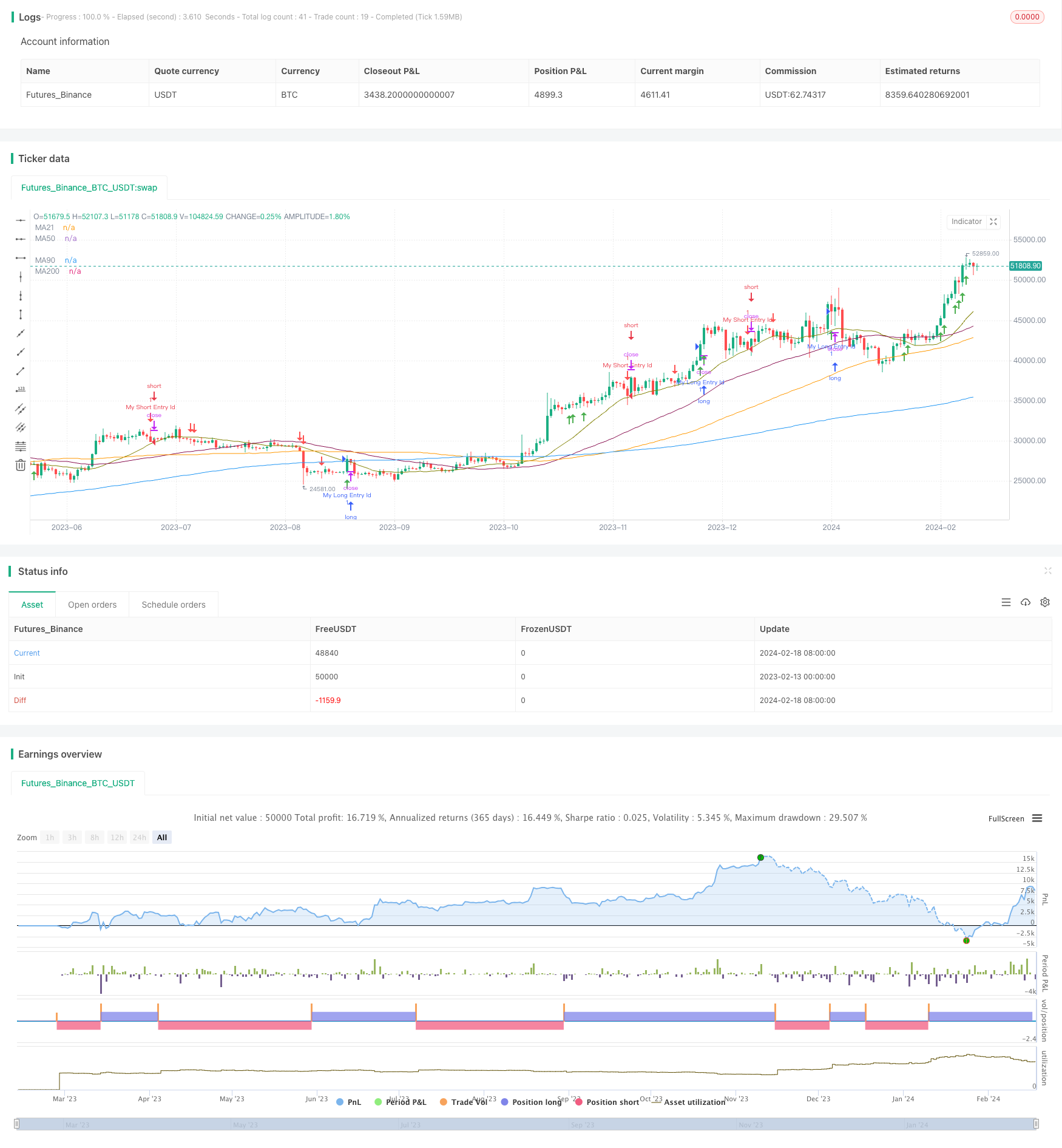
概述
本策略通过组合使用移动平均线、成交量指标以及价格动量指标,设计出一套量化规则,用以识别股票进入积累阶段的时机。在该阶段,股票通常处于价格的盘整和蓄势状态,提供了较低价格进场的良好机会。
策略原理
策略使用50日、90日和200日简单移动平均线来判断价格趋势。只有当价格高于200日线时,才产生买入信号。这可以过滤掉大趋势下跌的不确定性。
除了判断大趋势,策略还会判断短期均线顺序来确认趋势。具体来说,是判断50日线高于90日线。
在移动平均线确认大趋势和短期趋势符合条件的基础上,策略会结合成交量指标PVT和MACD指标来判断积累特征。只有当PVT向上突破、MACD线高于Signal线和成交量放大,才会产生买入信号。
策略优势
相比单一使用移动平均线,本策略在确认趋势的同时,还检查了成交量的特点。这可以更加准确判断股票进入积累阶段的时机,从而确保进场的价格优势。
通过多时间框架分析,本策略结合了中长期趋势判断和短期特征判断,时间框架匹配,可以减少因单一时间框架判断错误所带来的不确定性。
风险与解决
本策略主要依赖均线判断,当价格出现剧烈波动时,均线判断会失效。这时应降低仓位规模,或直接止损退出。
另外,积累阶段判断也可能出错,从而错过反转机会。这需要通过观察更多特征指标来确认判断。
优化思路
本策略可以引入机器学习算法,通过特征提取和模型训练,实现对积累阶段的自动判断。这可以减少因人工设置阈值而带来的局限性。
另外,本策略也可以尝试 breakpoint 功能,在不同市场环境下,自动切换不同参数,使策略更具鲁棒性。
总结
本策略总体采用价格与成交量匹配的思路判断股票积累特征。在确认大方向的同时,挖掘短期积累机会。 通过参数优化与机器学习等手段的引入,策略效果还有进一步提升的空间。
策略源码
/*backtest
start: 2023-02-13 00:00:00
end: 2024-02-19 00:00:00
period: 1d
basePeriod: 1h
exchanges: [{"eid":"Futures_Binance","currency":"BTC_USDT"}]
*/
// This source code is subject to the terms of the Mozilla Public License 2.0 at https://mozilla.org/MPL/2.0/
// © stocktechbot
//@version=5
strategy("Accumulate", overlay = true)
lookback = input(defval = 21, title = 'Lookback')
offset = input.int(title="Offset", defval=0, minval=-500, maxval=500)
//SMA Tredline
out = ta.sma(close, 200)
outf = ta.sma(close, 50)
outn = ta.sma(close, 90)
outt = ta.sma(close, 21)
//sma plot
plot(out, color=color.blue, title="MA200", offset=offset)
plot(outf, color=color.maroon, title="MA50", offset=offset)
plot(outn, color=color.orange, title="MA90", offset=offset)
plot(outt, color=color.olive, title="MA21", offset=offset)
//MarketCap Calculation
//MarketCap = 0.0
//TSO = request.financial(syminfo.tickerid, "TOTAL_SHARES_OUTSTANDING", "FQ", ignore_invalid_symbol = true)
//if str.tostring(TSO) != 'na'
// if ta.barssince(TSO != TSO[1] and TSO > TSO[1])==0
// MarketCap := TSO * close
//
// if barstate.islast and MarketCap == 0
// runtime.error("No MarketCap is provided by the data vendor.")
//
//momlen = 100
//msrc = MarketCap
//mom = msrc - msrc[momlen]
//plotmom = if (mom > mom[1])
// true
//else
// false
//OBV with sma on macd
obv = ta.cum(math.sign(ta.change(close)) * volume)
smoothingLength = 5
smoothingLine = ta.sma(obv,5)
[macdLine, signalLine, histLine] = ta.macd(ta.pvt, 12, 26, 9)
sellvolhigh = macdLine < signalLine
buyvolhigh = macdLine > signalLine
//Buy Signal
mafentry =ta.sma(close, 50) > ta.sma(close, 90)
//matentry = ta.sma(close, 21) > ta.sma(close, 50)
matwohun = close > ta.sma(close, 200)
higheshigh = ta.rising(high, 2)
higheslow = ta.rising(low, 2 )
twohunraise = ta.rising(out, 2)
//highvol = ta.crossover(volume, ta.sma(volume, lookback))
highvol = ta.rising(volume,2)
fourlow = ta.lowest(close, lookback)
fourhig = ta.highest(close, lookback)
change = (((fourhig - fourlow) / fourlow) * 100) <= 30
green = close > open
allup = false
lineabove = ta.cross(close, ta.sma(close, input(defval = 21, title = 'Entry Line')))
if matwohun and mafentry and higheshigh and twohunraise and buyvolhigh
//if higheshigh and higheslow and highvol
allup := true
plotshape(allup, style=shape.arrowup,location=location.belowbar, color=color.green, title = "Buy Signal")
barsSinceLastEntry() =>
strategy.opentrades > 0 ? bar_index - strategy.opentrades.entry_bar_index(strategy.opentrades - 1) : na
//Sell Signal
mafexit =ta.sma(close, 50) < ta.sma(close, 90)
matexit = ta.sma(close, 21) < ta.sma(close, 50)
matwohund = close < ta.sma(close, 200)
linebreak = ta.sma(close, input(defval = 21, title = 'Exit Line')) > close
lowesthigh = ta.falling(high, 3)
lowestlow = ta.falling(low, 2 )
twohunfall = ta.falling(out, 3)
twentyfall = ta.falling(outt, 2)
highvole = ta.crossover(volume, ta.sma(volume, 5))
//fourlow = ta.lowest(close, lookback)
//fourhig = ta.highest(close, lookback)
changed = (((fourhig - close) / close) * 100) >= 10
red = close < open
atr = ta.atr(14)
//atrsmalen = int(bar_index - strategy.opentrades.entry_bar_index(strategy.opentrades - 1) )
atrsmalen = barsSinceLastEntry()
atrsma = false
atrlen = 5
if str.tostring(atrsmalen) != 'NaN' and atrsmalen > 0
atrlen := atrsmalen
atrsma := atr > ta.sma(atr,50)
alldwn = false
if sellvolhigh and lowestlow and (close < close[1] and close < open)
//if higheshigh and higheslow and highvol
alldwn := true
plotshape(alldwn, style=shape.arrowdown,location=location.abovebar, color=color.red, title = "Sell Signal")
longCondition = ta.crossover(ta.sma(close, 14), ta.sma(close, 28))
if (allup)
strategy.entry("My Long Entry Id", strategy.long)
shortCondition = ta.crossunder(ta.sma(close, 14), ta.sma(close, 28))
if (alldwn)
strategy.entry("My Short Entry Id", strategy.short)